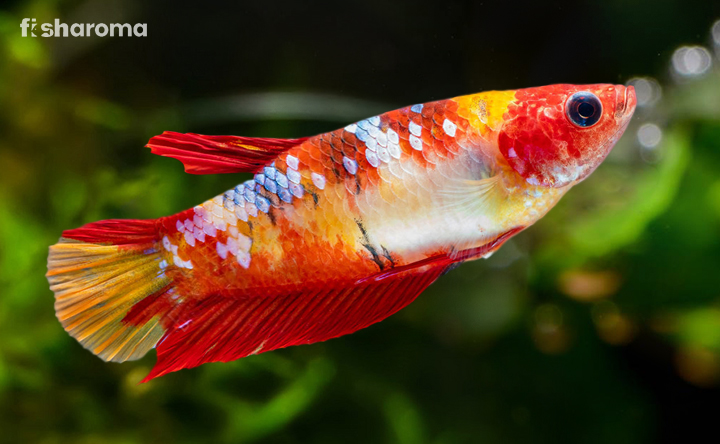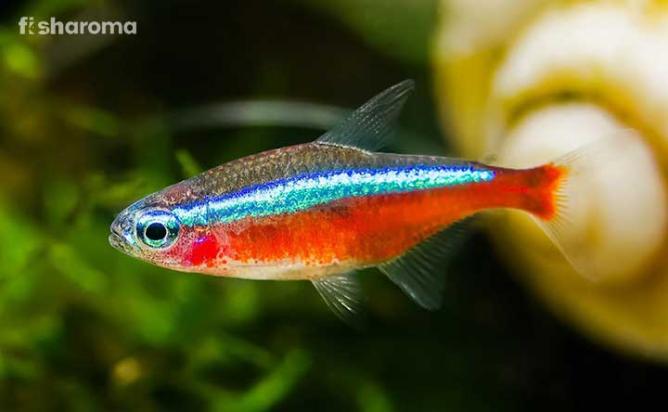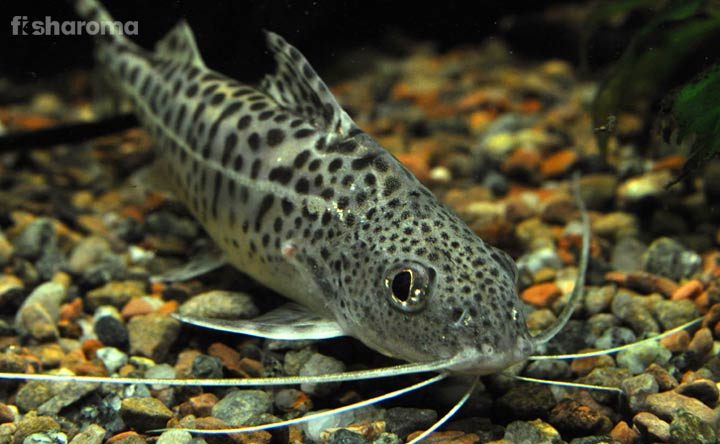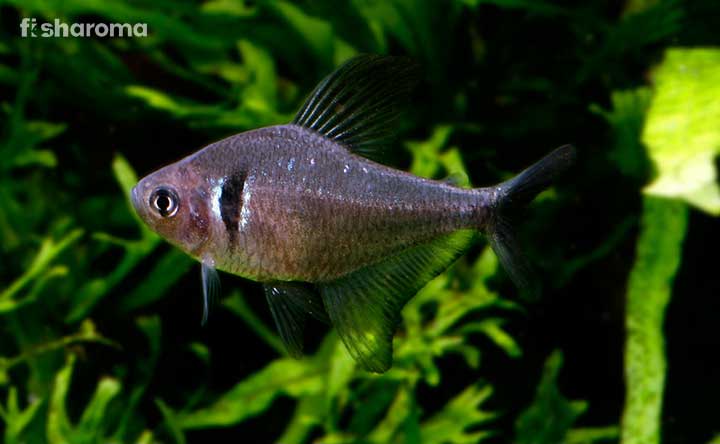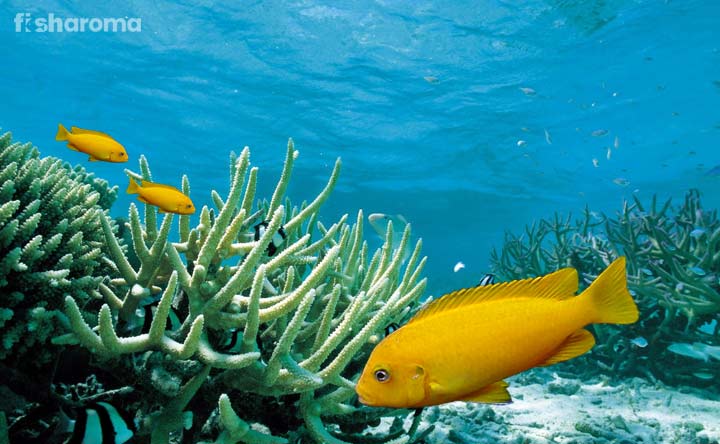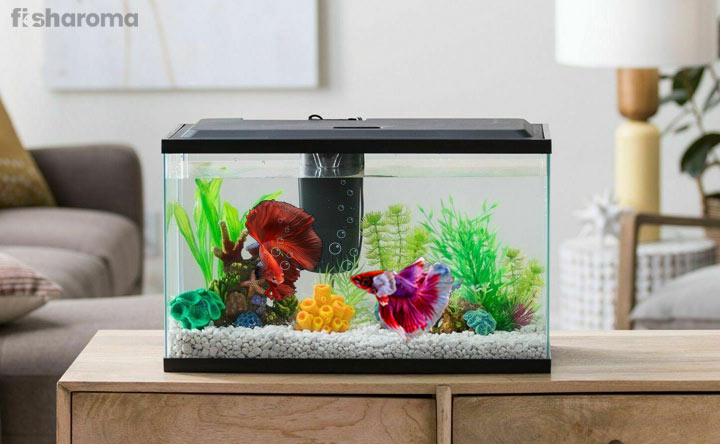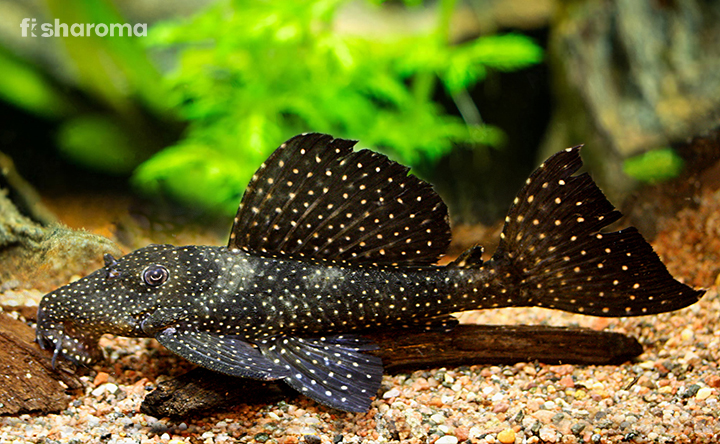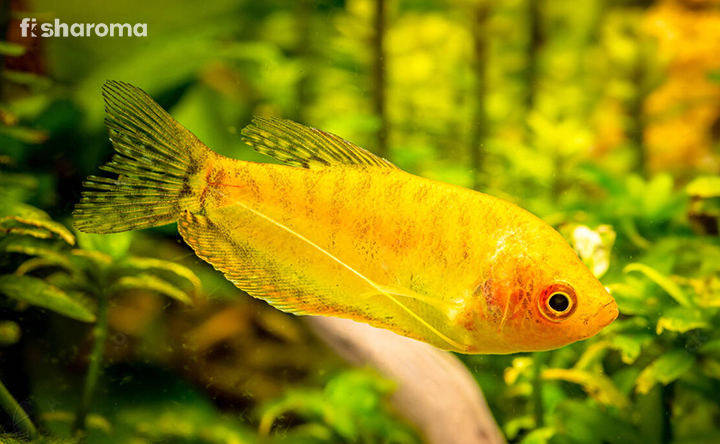Angelfish – The Complete Care Guide for the Regal Aqua Beauty

- Origin & Habitat of Freshwater Angelfish
- Appearance of Freshwater Angelfish
- Behaviour of Freshwater Angelfish
- Lifespan of Freshwater Angelfish
- Diet of Freshwater Angelfish
- Tank Requirements for Freshwater Angelfish
- Water Type for Freshwater Angelfish
- Compatibility of Freshwater Angelfish
- Breeding of Freshwater Angelfish
- Freshwater Angelfish Diseases
- Summary
One of the first choices for beginner fishkeepers, Angelfish are a spectacular species. Their regal beauty has rightfully earned them the title of “King of the Aquarium”. So, exactly what does their care guide entail? What are the aspects you need to keep in mind while petting them? What length do you have to go to provide a safe environment for them? We answer all these questions and more in our comprehensive Freshwater Angelfish care guide.
Key Specifications of Freshwater Angelfish
It is crucial to get yourself acquainted with the key specifications of your pet before diving deep into their care guide. So, take a look at their key specifications from the table below.
| Scientific Name | Pterophyllum scalare |
| Family | Cichlidae |
| Origin | South America |
| Size | 6” (15 cm) |
| Color | Black, silver, or gold with dark stripes |
| Care Level | Easy |
| Lifespan | 10 Years |
| Temperament | Semi-aggressive |
| Compatibility | Moderate |
| Tank Size | 20 Gallons |
| Diet | Omnivore |
Overview
The highly popular Freshwater Angelfish belongs to the Cichlidae family. These disc-shaped beauties are timid creatures that get quickly startled. They were first described by Schultze in the year 1823 and were introduced in Europe in around 1920. By 1930, they were being bred in the United States.
They are also known by other names such as Common Angelfish or Silver Angelfish. Their scientific name is Pterophyllum scalare.
Freshwater Angelfish are often confused with Marine Angelfish because of the similarity in their names. However, they are different from one another since the latter belongs to the Pomacanthidae family.
Origin & Habitat of Freshwater Angelfish
Native to South America, they can be found in the central Amazon River basin and its tributaries, specifically in Brazil, Peru, and eastern Ecuador.
They are usually seen in flooded zones and in swamps that have thick vegetation. They can survive in both clear water and silty water, but clear water helps in bringing out their colors better.
Appearance of Freshwater Angelfish
With a diamond-shaped compressed body, they are identified by their trademark trailing pectoral and dorsal fins alongside their fan-shaped caudal fin. Their elegant forms help them in swimming gracefully. In some variants, the tail fins develop streamers on the outside corners.
You will hardly find any resemblance in their appearance with other members of the Cichlidae family. Their body shape could also be compared to arrowheads.
Size of Freshwater Angelfish
On average, a Freshwater Angelfish grows up to 6” (15 cm), and if you take into account their fins, the total length can be 8” (20 cm).
Color of Freshwater Angelfish
A significant feature of their appearance is their striking bands over their bodies. Most Freshwater Angelfish have a silver body along with four black, prominent bands.
There is also an intriguing variant of this species, known as Marbled Angelfish, which has irregular, jarred bands or even black spots instead of straight black bands.
The popularity of these fish has also led to the breeding of various fancy variants, mostly for ornamental purposes. Few black, golden and platinum variants don’t have any bands on them. There is a Panda variant that has white scales with black patterns. A Koi variant also exists that is white or silver with red and orange spots on them.
Based on their colors, some variants of Freshwater Angelfish hare as follows:
- Albino Angelfish
- Chocolate Angelfish
- Ghost Angelfish
- Zebra Angelfish
- Smokey Angelfish
- Gold Marble Angelfish
- Silver Gold Marble Angelfish
- Half Black Silver Angelfish
- Gold Pearscale Angelfish
- Blue Blushing Angelfish
- Leopard Angelfish
- Sunset Blushing Veil Angelfish
- German Red Angelfish
- Black Hybrid Angelfish
Behavior of Freshwater Angelfish
There are undoubtedly traits of aggression in their behavior, which is a common factor for most of the members of the Cichlidae family. In their juvenile stage, they are rather peaceful and can survive in a school, but as they grow up, they break into pairs and become more and more territorial by nature.
They are not the most social creature that you can host in your tank. However, it should be noted that their aggression level is comparatively lower than most Cichlids.
They love hiding, although they are more or less a showy fish. They spend most of their time at the mid-level of the tank.
Lifespan of Freshwater Angelfish
For all those who are looking for long-living aquarium species, we can recommend Freshwater Angelfish because they can survive for up to 10-15 years if taken care of.
They reach their maturity at the age of ten months. This also means you have to prepare yourself for a long-term commitment for taking care of them.
Diet of Freshwater Angelfish
They are omnivores, although they mostly rely on live prey to satiate their diet. In their natural habitat, they consume crustaceans, insects, larvae, rotifers, and even small species of fish. They also consume algae and plant matter but in meager quantities.
When kept in captivity, you should ensure that they have access to a lot of live food due to their heavy requirement of fiber and protein. Absolute favorite sources of food for these creatures are Tubifex worms. Brine Shrimp and water fleas are also great food options for them. You can also provide them Krill and freeze-dried Glassworms.
Pellets and flake foods can also serve as their staple diet since they have a high content of protein in them. In addition, include blanched garden vegetables such as spinach, romaine, and zucchini in their diet.
You have to feed them twice daily, and mated pairs whom you are planning to breed, have to be fed four times a day.
Tank Requirements for Freshwater Angelfish
It is very important for providing a home-like environment for your pet. To help you do that, we are listing out the various factors you need to bear in mind while setting their tank. So, here we go.
Tank Size
For keeping a pair together, you would need at least a 20-gallon tank. If you are planning to host a small school of Freshwater Angelfish in your home, bring an 80-gallon tank. For each Angelfish you add to your tank, provide 10 gallon space.
Substrate
The substrate that you pick for them should be soft in order to protect your pets from any cuts, bruises, or scrapes to their fins and scales. Fine sand substrate mixed with non-sharp small gravels will suit very well for them; so will any mud-based substrate.
Filter
Install a filter in their tank that is capable of oxygenating the tank water as well as in keeping the quality of the water good. Besides, they prefer moderate water movements in their tank. So, your filter must be able to do that as well.
Having a proper filter will also help in the thriving of beneficial bacteria, which is a must for the survival of your pet. An under-gravel filter will get the job done.
Nature of Lighting
In the wild, light easily penetrates the water that they live in. Therefore, make sure that the tank which hosts your Freshwater Angelfish has access to proper lighting. These fish need exposure to lighting for 8-12 hours a day. As far as the type of lighting is concerned, well, any lighting system that mimics sunshine will suffice for them.
However, avoid direct sunlight or overexposure to light since that would lead to the growth of algae in your tank.
Presence of Flora
As we have stated above, their natural habitat is dominated by thick vegetation. They are mainly found in swamps. So, feel free to include those plants which are found in the Amazon River basin.
These can include
- Anacharis
- Brazilian Pennywort
- Amazon Grass
- Amazon Sword Plant
- Melon Sword
- Water Milfoil
Look out for plants that have broad leaves like the Amazon Sword Plant since they will serve as hiding spots for them.
Apart from the native water plants of South America, you can also include Java Moss and Java Fern in their tank.
You need to avoid keeping floating vegetation such as Pondweed and Duckweed in the tank that hosts Freshwater Angelfish since these plants are known to block out the light as well as be the reason for overcrowding.
Ornaments
When it comes to ornaments, remember less is more. Yes, feel free to include caves, rocks, driftwood, or even castles since they love hiding; but remember not to block the swimming space of your pet. The moot idea should be to provide a space to them where they can freely swim.
Besides, you must ensure that the ornaments you pick are non-sharp and are not made of any toxic materials. The holes of your castles and caves should be large enough so that your fish doesn’t get trapped in them.
Cleaning Method
Cleaning your tank every month (or whichever time interval suits you) will help maintain good health inside the aquarium. Now, while cleaning the tank, the following points must be kept in mind:
- Don’t use any soap-based or chemical-based products to clean to tank.
- Use lukewarm water to wipe off the interior walls of your tank.
- Vacuum clean your substrate using a siphon.
- Put the ornaments under running tap water to clean them.
- Regularly trim your aquatic plants so that they don’t run wild.
Water Type for Freshwater Angelfish
It is probably the single most important aspect of fishkeeping. Having a thorough knowledge of the type of water you need to provide them is crucial. So, follow through each of the following sub-headings under this section.
Temperature
First of all, place a heater in your tank and set the temperature anywhere between 75-82° F (23.9- 27.8° C). If your heater doesn’t come with a temperature reading, get a submerged thermometer so that you can keep a check on the temperature always.
pH Level
The ideal pH level for Freshwater Aquarium is 6.0-7.5. Buy pH testing strips to test the pH level of the tank water regularly.
Mineral Level
Keeping a check on the mineral level is also essential so that the environment inside the tank doesn’t become toxic. For Freshwater Angelfish, the level of ammonia and nitrite should be 0 (zero), while the level of nitrates should be less than 20 ppm.
Hardness
The general hardness of the tank water should be 2-10 dGH.
Replacement Procedure
As with cleaning the tank, regular replacement of the tank water will ensure that your pet fish is free from diseases. One mistake that many beginner fishkeepers make is replacing the entire tank water altogether.
We can’t stress enough as to how wrong this is since it will lead to the death of all beneficial bacteria. The portion of tank water that you replace will depend on how frequently you are changing the tank water. The following table will give you an idea of it. Remember, to pick only one of these three following systems. Besides, the new batch of water that you add to the tank should have the same temperature, pH level, hardness, and mineral level as that of the existing batch of water.
| Time Interval of Water Change | Percentage of Total Water to be Replaced |
| Weekly | 15% |
| Bi-weekly/Fortnightly | 25% |
| Monthly | 40% |
Compatibility of Freshwater Angelfish
The natural habitat of Freshwater Angelfish is a biodiversity hotspot. In the Amazon River basin, they live alongside thousands and thousands of different fish species.
However, it is still suggested to keep them in a single species tank. You can keep them in a school of 6-8 individuals, although as they grow up, their territorial instinct will also heighten, which means you must provide ample space to them.
Suitable Tankmates for Freshwater Angelfish
Go for peaceful or semi-aggressive species that have a similar temperament to that of Freshwater Angelfish while choosing their tankmates.
The suitable tankmates for a Freshwater Angelfish are as follows:
- Dwarf Gourami
- Dwarf Cichlid
- Discus
- Rubbernose Pleco
- Silver Dollar
- Silver Arowana
- African Leaf Fish
- Bolivian Ram
- German Blue Ram
- Molly
- Platy
- Pictus Catfish
- Cory Catfish
- Arapaima
Unsuitable Tankmates for Freshwater Angelfish
The first key point which you need to keep in mind while selecting tankmates for them is that avoid small species that might be eaten, attacked, or bullied by them. Next, avoid keeping them with fin-nippers since Angelfish have delicate fins. Finally, don’t keep them with other aggressive species for obvious reasons.
Therefore, some of the unsuitable tankmates for a Freshwater Angelfish are as follows:
- Barb
- Oscar
- Convict Cichlid
- African Cichlid
- South American Cichlid
- Small crustaceans
Breeding of Freshwater Angelfish
These fish are extremely easy to breed, which is an absolute bonus for those who prefer breeding than buying young fries. They naturally pair themselves when introduced to a school. This is why it is advised to rear them from a young age in a group of 6-8. You can easily recognize a pair since you will notice them setting a territory of their own. Once you have identified the pair, prepare them for breeding.
Make way for a separate breeding tank that has a size of around 20 gallons. The temperature of the tank must be 82° F (27° C), the pH level should be 6.5, and the general hardness must be 5 dGH. Make sure it has a slanted, vertical surface alongside a low flow filter. You can also keep PVC pipes, tiles, or even aquatic plants such as Anacharis that will serve as great spawning surfaces.
As stated above, the pair that you are about to breed must be fed four times a day, and their diet should consist of live Tubifex worms and high protein flakes.
During mating, the males often make grating sound with their jaws. The females generally lay 200-400 eggs every time they spawn, and the males will follow up by externally fertilizing them. The eggs hatch within 36-48 hours. They are very defensive parents and guard the eggs and fries for almost a month, after which you can transfer the parents to the main tank.
After Care
Make sure that the water is oxygenated enough so that your fries grow up healthily. Feed your fries Brine Shrimp larvae along with hard-boiled eggs till they are 5-7 weeks of age. You can then proceed to feed them flake foods.
After a period of 6-8 weeks, you can transfer your juveniles to your main tank. But, keep a close watch over them so that they don’t get attacked by other fish.
Freshwater Angelfish Diseases
They are just like any other freshwater fish that are susceptible to various diseases. These diseases can result from poor quality of the water or low oxygenation in the tank or even stress from unsuitable tankmates.
One of the most common diseases that they often suffer from is Ich. It is identified by white spots on the bodies and fins of your fish. It is recommended to elevate the temperature of the tank water to 86° F (30° C) for a couple of days in order to treat the disease. Copper medication can also be resorted to if increasing the temperature doesn’t get the job done. However, we advise heading for medical help rather than trying home remedies.
Besides, Angelfish can suffer from intestinal diseases, parasitic infections, bacterial infections, or fungal infections, all of which require getting the help of a veterinarian.
We highly recommend quarantining everything you put in your tank, including your Freshwater Angelfish and their tankmates. You never know what may carry the fungus, bacteria or parasite. So, quarantine everything – substrate, aquatic plants, and ornaments – before you introduce them to your aquarium.
Interesting Facts about Freshwater Angelfish
- Some variants of Freshwater Angelfish are exclusively bred to resemble Goldfish.
- The first part of their scientific name, which is the genus name – Pterophyllum – has been kept in relation to their appearance since it means “winged leaf”.
- Female and male Freshwater Angelfish look the same. It is only when the females get pregnant, their bodies plump up, which is the only way of distinguishing the females from the males.
Summary
Freshwater Angelfish are rightfully called the “King of the Aquarium” for their magnificent appearance. They are extremely popular across the globe and are highly recommended for beginner fishkeepers since caring for them is fairly easy.
The territorial behavior of Freshwater Angelfish requires you to keep them in a species-only tank, although they are compatible with many other freshwater species. Breeding them is an effortless process. In addition, their housing demands are pretty easy to fulfill. So, what are you waiting for? Bring these angels home and stay intrigued by their mystical behavior.
Care Guides of Other Freshwater Fish
If you are interested in freshwater aquariums, you might want to take a look at some of our other care guides.
- Bolivian Ram Care Guide – The magnificent appearance of a Bolivian Ram has to be seen to be believed. This, along with their friendly nature (with moments of aggression) makes them quite an intriguing pet.
- Rope Fish Care Guide – Despite their intimidating appearance, they are pretty docile and peaceful and are suitable for those who prefer unconventional pet species.
- Crowntail Betta Care Guide – Famous for their artistic fins, Crowntail Bettas are counted amongst the most aggressive freshwater aquarium species.

